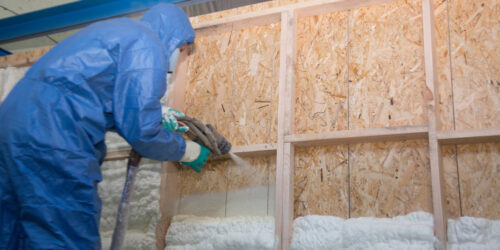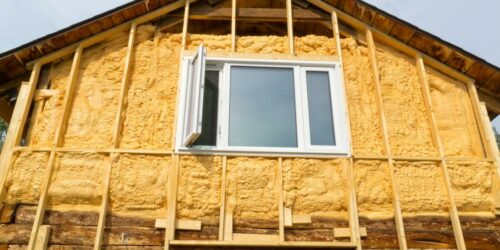Can I Install DIY Spray Foam Insulation Myself?
- Overview of spray foam
- Why DIY spray foam insulation is a bad idea
- Costs and advantages
Many people wonder if DIY spray foam insulation is a good idea instead of consulting the professionals. If you do want to install spray foam insulation and are wondering how risky it is to do so without outside help, this article is for you. Find out more about spray foam insulation and the pros and cons of self-installation right here.
Opting for the professional touch? Use our quote comparison tool to find out how much you'd pay. It only takes a minute.

What's On This Page?
Click the links below and head straight to a specific section of the article.
- Why Is Insulation So Important?
- What Are the Pros and Cons of Spray Foam Insulation?
- How Does Spray Foam Work?
- What Kinds of Spray Foam Insulation Are Available?
- Closed-Cell Spray Foam Insulation
- Open-Cell Spray Foam Insulation
- Should I Carry Out DIY Spray Foam Insulation?
- Can Spray Foam Be Installed Without Plasterboard Being Removed?
- Can Foam Be Sprayed Over Your Existing Insulation?
- How Much Does Spray Foam Insulation Cost?
- Reasons to Get a Specialist Involved
- DIY Spray Foam Insulation Conclusion
Why Is Insulation So Important?
Insulating your home is a great way to cut your energy costs and make a better contribution to the environment. By adding solutions like spray foam insulation to your property, you can make it a better place to live, save money and reduce your carbon footprint at the same time. There are many different insulation products available on today’s market, and spray foam has become one of the most popular options around over recent years. To cut costs, you may be wondering about whether DIY spray foam insulation is a good idea. In actuality, things could end up a lot worse if you don't use a professional.
What Are the Pros and Cons of Spray Foam Insulation?
Spray foam is incredibly versatile and is often used to insulate floors, walls, roofs and lofts. One of the biggest benefits of spray insulation is that it can be applied to hard-to-reach areas. It can also provide extra soundproofing in some cases. On the downside, it's likely to cost you more than other forms of insulation. Once you have had it installed, it can be difficult to remove. It also affects the value of some properties, and you can’t normally decorate over it. It’s advised to have it installed by a professional as things can get very difficult to rectify if something goes wrong during the installation process. This is why DIY spray foam insulation is never considered a good idea.
How Does Spray Foam Work?
Spray foam insulation is a liquid foam that needs to be sprayed into position. It then sets into an insulation layer. It has been around for over three decades and has become increasingly popular amongst property owners looking for new ways to prevent air leakage. Although DIY spray foam insulation is possible, it's not recommended.
What Kinds of Spray Foam Insulation Are Available?
There are two main kinds of spray foam insulation available. These are closed-cell and open-cell spray foam. Both of these forms of insulation are normally made from polyurethane and filled with gas or air bubbles. However, they have different properties once they have set. All the more reason to be wary of DIY spray foam insulation.
To learn more about different types of loft insulation, read our accompanying guide.
Closed-Cell Spray Foam Insulation
Closed-cell spray foam sets into a rigid solid. If you have an older home and it’s not in a great condition, this might help support its structure. This kind of insulation is a more efficient insulator than open-cell spray foam. Once it has set, it has many separate gas pockets that slow down heat moving through it. The room that you are installing closed-cell spray foam in will need to be ventilated well, as the insulator can block moisture. A professional job over DIY spray foam insulation will take this into account.
Open-Cell Spray Foam Insulation
Open-cell spray foam isn’t as effective as closed-cell spray foam.
It isn’t as dense once set, which means you'll need to install a thicker layer. However, moisture can pass through this kind of insulation, which can help you win the battle against condensation. If you're sold on performing DIY spray foam insulation, this may be the better option.
Should I Carry Out DIY Spray Foam Insulation?
DIY spray foam insulation can be very risky. Although you may be able to make short-term savings when you attempt to install it yourself, there’s a high chance something may go wrong during the process. If your installation isn’t of sufficient quality, you could damage the plasterboard inside your home, and you may face big problems with mould. It may cost you a great deal of money to put things right if you don’t carry out the installation of DIY spray foam insulation properly. Unless you have a great deal of experience, it’s much better to leave things to the professionals. Installing spray foam insulation requires considerable skill and expertise.
Can Spray Foam Be Installed Without Plasterboard Being Removed?
A common question about DIY spray foam insulation is whether it can be installed without plasterboard being removed. It’s much better to remove it first as spray foam can expand very rapidly once applied. If you attempt to add the insulation without removing the plasterboard, expanding foam could overfill the panel, with pressure being exerted to the inside of the plasterboard. There’s a big chance that it could crack or break.
It is highly advisable to remove plasterboard before you start to install DIY spray foam insulation. You could attempt to remove plasterboard yourself, but this task can be very time-consuming as well as messy, which is why it’s such a good idea to get the professionals involved. An experienced professional will know how much plasterboard they need to remove and should get the job done quickly. If you are considering looking at alternatives to spray foam, you could always consider installing fibreglass instead.
Can Foam Be Sprayed Over Your Existing Insulation?
It is highly inadvisable to install DIY spray foam insulation over your current insulation. Spray foam can be very sticky, but it doesn’t stick very well to types of insulation including fibreglass insulation. If you combine both of these types of insulation, you are likely to reduce the efficiency of each. Spray foam is unlikely to fill gaps in your fibreglass insulation very effectively, and it’s likely that the form won’t form around the fibreglass very well.
If the foam has gaps, it won’t be very efficient at transferring heat or resisting moisture. Making DIY spray foam insulation by combining both open-cell and closed-cell can result in an inferior product, and water vapour could build up inside your walls. This can lead to problems with mould, which can affect the health of you and your family whilst devaluing your property. It’s essential to remove your old insulation when you’re adding spray foam insulation to your property.
How Much Does Spray Foam Insulation Cost?
Prices for spray foam insulation installation can vary. Factors that might influence the price that you pay include how much you need, your location and the amount of time required to get the job done. Although spray foam isn’t the cheapest form of insulation available, it can help you reduce your energy costs substantially and save you a considerable amount of money in the long run. The cheapest costs can be with a DIY spray foam insulation job, but just because it's cheaper doesn't mean the job will be done well.
You can see rough costs outlined in the interactive graph below, but these are averages and can vary wildly. The highest cost for professional installation of spray foam is around £90/m², according to Checkatrade. Even though a DIY spray foam insulation job can be cheaper, if anything goes wrong with the installation, you can end up paying much more to correct it.
Reasons to Get a Specialist Involved
There are many good reasons for using a specialist instead of attempting a DIY spray foam insulation job yourself. A professional installer will be able to help you find the right materials for the job and use specialist tools to ensure the installation is an efficient one.
It is possible to get the DIY spray foam insulation job done well if you spend enough time carrying out all the research required and take your time when carrying out the work. However, there is a big chance something might go wrong, so it is highly advisable to leave things to an experienced professional to remove the risk. A specialist can also carry out an audit on your home and examine your property for any air leaks and energy loss problems that might exist.
Another reason why things might go wrong with a DIY spray foam insulation installation is that you could buy too much material for the project, or not enough. Not purchasing the right amount of material can cause your project to go over budget and take much more time than it needs to. By allowing a specialist to carry out a home energy audit, you can get an accurate idea of what the project will cost you so you don’t end up over-spending, or not spending enough to make the installation an efficient one.
It's clear to see why so many people are tempted to carry out a DIY spray foam installation. However, there are many risks attached to doing this, such as damaging your property and unwittingly encouraging the growth of mould. The long-term costs of DIY spray foam insulation can be substantial.
DIY Spray Foam Insulation Conclusion
If you have cavity walls that are hard-to-reach or solid walls that you can’t add external insulation to for any reason, spray foam insulation may well be the option for you. You may also benefit from spray foam insulation if you live in an area that floods from time to time. This is because some foam insulation products are waterproof and breathable. In any case, we don’t recommend carrying out a DIY spray foam insulation installation.
Related articles
View all Insulation articles
How Long Does Spray Foam Insulation Last?

Six Benefits of Spray Foam Insulation

Is My Property Suitable for Spray-On Insulation Foam?

Why Consider Spray Foam Insulation in Roofs?

Icynene Spray Foam Insulation: A Complete Guide

Spray Foam Insulation Installers: What to Expect

Open Cell vs Closed Cell Spray Foam Insulation: What’s The Difference?







